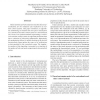Free Online Productivity Tools
i2Speak
i2Symbol
i2OCR
iTex2Img
iWeb2Print
iWeb2Shot
i2Type
iPdf2Split
iPdf2Merge
i2Bopomofo
i2Arabic
i2Style
i2Image
i2PDF
iLatex2Rtf
Sci2ools
DSRT
2005
IEEE
2005
IEEE
Modeling Decentralized Real-Time Control by State Space Partition of Timed Automata
Timed automata provide useful state machine based representations for the validation and verification of realtime control systems. This paper introduces an algorithmic methodology to translate the state space visualization of a centralized real-time control system to a decentralized one. Given a set of timed automata representing a centralized real-time control system, the algorithm partitions them into a collection of interacting submachines. Importantly, this methodology allows for model-checking of the derived decentralized system against the same set of verifications as that specified for the centralized system. The complexity analysis of the algorithm is presented as a function of the number of tasks and nodes comprising the decentralized system.
Centralized Real-time Control | Control System | DSRT 2005 | Modelling And Simulation | Real-time Control System |
| Added | 24 Jun 2010 |
| Updated | 24 Jun 2010 |
| Type | Conference |
| Year | 2005 |
| Where | DSRT |
| Authors | Thanikesavan Sivanthi, Srivas Chennu, Lothar Kreft |
Comments (0)

